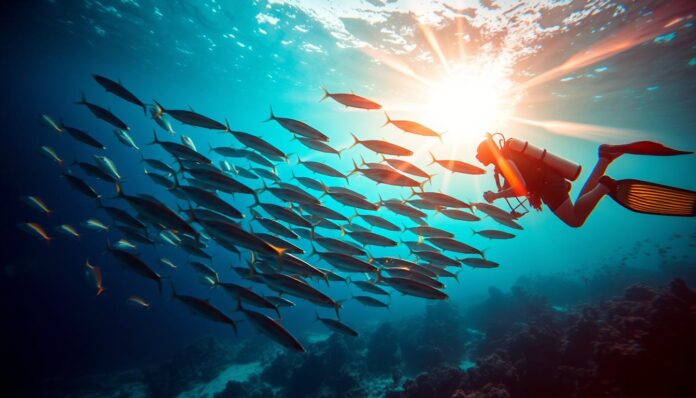Did you know barracudas can swim over 40 km/h when hunting? These fast predators make scuba diving with them an exciting adventure for many.
Barracuda fish are a top choice for adventurous divers. They dive in places like Sipadan’s Barracuda Point. Here, they show off their speed and mystery.
Imagine diving in clear waters with barracudas. You’ll see their amazing hunting skills and unique behaviors. This guide will help you explore their underwater world.
Key Takeaways – Diving with Barracuda
- Discover the incredible speed and hunting capabilities of barracudas
- Learn about unique marine life encounters with barracuda fish
- Explore world-renowned diving locations featuring barracuda populations
- Understand safety techniques for scuba diving with barracuda
- Gain insights into barracuda behavior and ecological significance
What Makes Barracuda an Exciting Dive Companion?
Scuba diving with Barracuda is an electrifying experience. It turns a normal dive into an amazing adventure. These sleek predators create mesmerizing underwater landscapes. They captivate divers and underwater photography enthusiasts alike.
Barracudas are remarkable creatures with unique characteristics. They make fascinating dive companions. With about 20 different species worldwide, they add incredible diversity to marine ecosystems.
Understanding Barracuda Behavior
The behavior of barracudas is complex and intriguing. They show fascinating social patterns:
- Form impressive schools numbering in the hundreds
- Can swim at remarkable speeds up to 22 mph
- Display curious nature towards divers
- Primarily hunt smaller fish like anchovies and sardines
The Thrill of Encountering Barracuda
Encountering barracudas during underwater photography sessions is thrilling. The great barracuda, which can grow up to 5 feet long, often shadows divers. It does so with an intense, predatory gaze.
“Diving with barracudas is like entering a living, breathing underwater ballet of precision and power.” – Marine Biologist
While some divers might feel intimidated by their sharp teeth, barracudas are generally non-aggressive. Most species, like the Pacific barracuda, tend to be shy. They keep a respectful distance from human divers.
Best Locations for Scuba Diving with Barracuda
Exploring the world’s top diving spots for barracudas needs careful planning. Scuba fans look for places that offer amazing marine life experiences.
Top Dive Spots Around the World
Barracuda enthusiasts have many incredible places to dive. Some of the best spots include:
Asia:
- Maldives: The Maldives archipelago is renowned for its crystal-clear waters and vibrant marine life, including barracudas. Dive sites like Fotteyo Kandu and Maaya Thila offer excellent opportunities to witness barracudas in their natural habitat.
- Malaysia: The waters of Malaysia, particularly around the islands of Sipadan and Layang-Layang, are home to an abundance of barracudas. These dive sites are known for their strong currents, which attract schools of barracudas and other pelagic species.
- Indonesia: The Indonesian archipelago offers numerous dive destinations where barracudas are commonly sighted. Raja Ampat, Komodo National Park, and the famous dive site known as “The Point” in Bali are just a few of the many places to encounter barracudas in Indonesia.
- Egypt: The Red Sea in Egypt is renowned for its diverse marine life, and barracudas are a common sight here. Dive sites such as the Brothers Islands, Daedalus Reef, and the famous Thistlegorm wreck offer thrilling barracuda encounters.
- Seychelles: The pristine waters of the Seychelles are home to barracudas, alongside an array of other marine species. Dive sites like the Aldabra Atoll and the St. Pierre Island Marine Park provide opportunities to dive among barracudas in stunning underwater seascapes.
- Cayman Islands: The Cayman Islands are known for their spectacular wall dives and abundant marine life, including barracudas. Sites such as the North Wall in Grand Cayman and the Bloody Bay Wall in Little Cayman offer opportunities to dive alongside these sleek predators.
- Turks and Caicos: The turquoise waters of Turks and Caicos attract barracudas to their vibrant coral reefs. Dive sites like West Caicos and French Cay are famous for barracuda encounters, where you can witness their impressive hunting prowess.
- Belize: The Belize Barrier Reef, a UNESCO World Heritage site, is a haven for barracudas. Diving at sites like the Great Blue Hole and Lighthouse Reef offers the chance to witness barracudas alongside other fascinating marine species.
- Honduras: The Bay Islands of Honduras, including Roatán and Utila, are known for their thriving underwater ecosystems. Here, divers can enjoy encounters with barracudas at sites like Mary’s Place and the El Aguila wreck.
- Red Sea (Egypt and Jordan): The Red Sea, with its accessibility from Egypt and Jordan, offers outstanding opportunities to dive with barracudas. Dive sites like Ras Mohammed National Park in Egypt and the Aqaba Marine Park in Jordan provide incredible barracuda encounters.
- Australia: The Great Barrier Reef in Australia is a world-renowned diving destination teeming with marine life, including barracudas. Locations like the Ribbon Reefs and Osprey Reef are known for barracuda sightings amidst the stunning coral formations.
- Florida, USA: The warm waters of Florida attract barracudas to various dive sites. The Florida Keys, including areas like Molasses Reef and the Spiegel Grove wreck, offer opportunities to dive alongside these sleek predators.
- Galápagos Islands, Ecuador: The Galápagos Islands are a haven for unique and diverse marine species, including barracudas. Diving in this volcanic archipelago provides unforgettable encounters with barracudas in the company of other iconic marine creatures.
- Cocos Island, Costa Rica: Cocos Island, a UNESCO World Heritage site, is renowned for its thrilling diving experiences. Here, barracudas can be encountered alongside hammerhead sharks, manta rays, and other pelagic species, creating a true underwater adventure.
These are just a few of the many destinations around the world where divers can experience the thrill of diving with barracudas. Each region offers its unique charm, dive conditions, and marine biodiversity, ensuring that every encounter with barracudas is a memorable and awe-inspiring experience.
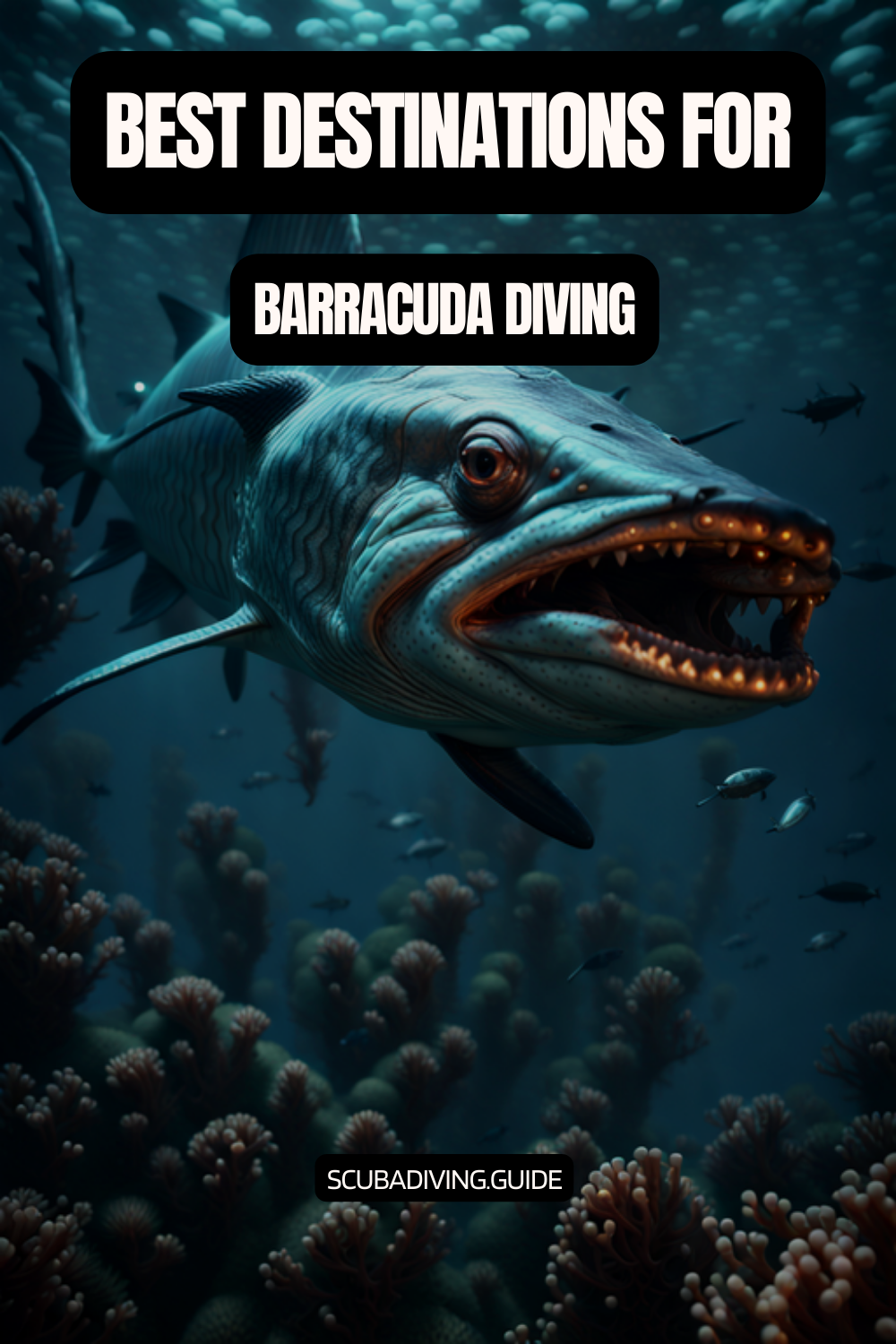
National Parks and Marine Reserves
Protected marine areas offer real barracuda diving tours. Key spots include:
- Hol Chan Marine Reserve in Belize
- Dampier Strait in Indonesia
- Shark Ray Alley in the Caribbean
Water temperatures range from 60-86°F, so divers need the right gear for each place.
Professional diving resorts suggest getting advanced certification for tough spots. Experienced divers can visit many sites and have the best underwater adventures.
Safety Precautions When Diving with Barracuda
Scuba diving with barracuda requires careful planning and understanding of safety. These fascinating predators rarely attack humans. But knowing the right precautions can make an encounter safe and memorable.
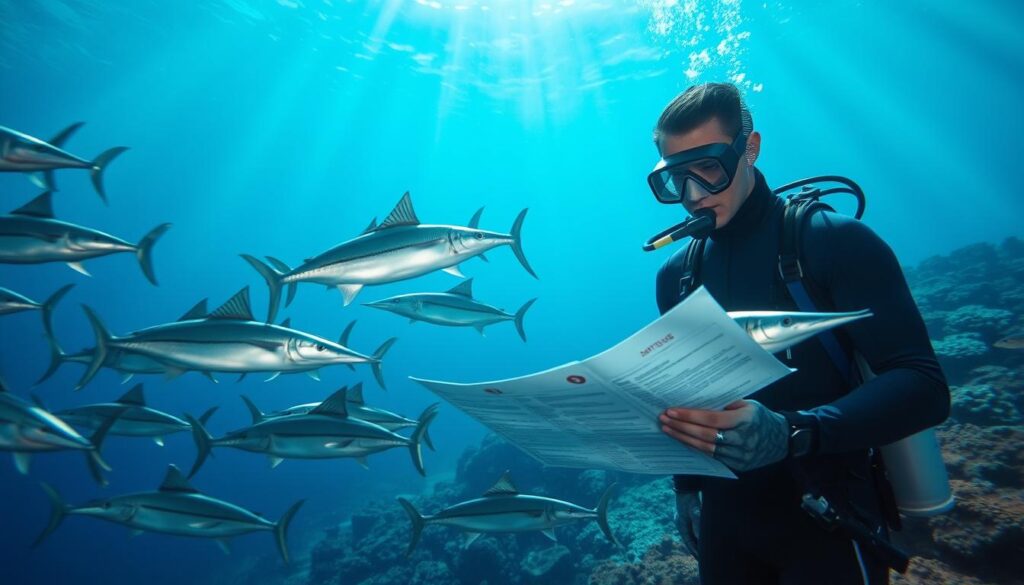
Divers need to know that barracuda behavior can be unpredictable. Some actions might trigger aggressive responses. So, choosing the right scuba gear and being mindful of your actions are key for safety.
Understanding Barracuda Aggression Patterns
Barracuda interactions are complex and often misunderstood. Research shows they might follow a unique three-strike pattern during confrontations:
- Initial reconnaissance
- Threat assessment
- Potential engagement
Essential Dive Safety Strategies
Professional divers suggest several key strategies for safe barracuda encounters:
- Avoid wearing reflective or shiny scuba gear
- Maintain calm, deliberate movements
- Do not carry spearfishing equipment
- Keep a respectful distance from schools of barracuda
“Respect the marine environment, and it will respect you back.” – Marine Diving Expert
Gear Tips for Maximum Safety
Choosing the right scuba gear is vital for safety. Wetsuits with neutral colors and minimal reflective elements can help avoid barracuda interest.
Remember: Your behavior matters more than any single piece of equipment when diving near these magnificent predators.
Statistically, unprovoked barracuda attacks are extremely rare. By understanding their behavior and diving responsibly, you can turn a potentially scary encounter into an unforgettable underwater adventure.
Ideal Conditions for Scuba Diving with Barracuda
Scuba diving with Barracuda is an exciting underwater adventure. Knowing the best conditions can make your dive better and increase your chances of seeing barracudas.
The underwater world is full of challenges and opportunities. Preparing well and knowing important environmental factors can turn a regular dive into an amazing journey.
Optimal Water Temperature for Barracuda Encounters
Barracudas love warm tropical waters. The best times for seeing them are when the water is just right. Here are some key temperature tips:
- Ideal water temperatures range between 75-85°F (24-29°C)
- Peak barracuda activity occurs during warmer months
- May to September represents the optimal diving season
Visibility and Current Factors
Knowing the underwater conditions is key for a great dive with Barracuda. Visibility and currents are important for seeing marine life.
| Condition | Details | Diving Impact |
|---|---|---|
| Visibility | 10-30 meters (33-98 feet) | Excellent marine life observation |
| Dive Depth | 20-35 feet (6-11 meters) | Suitable for open water divers |
| Barracuda Sighting | Approximately 50% chance | Thrilling encounter probability |
“The underwater realm reveals its secrets to those who approach with respect and knowledge.” – Marine Exploration Society
Currents can affect barracuda behavior. Gentle to moderate currents often attract these fascinating predators, making for unforgettable dives.
By understanding these key factors, divers can make their scuba diving with Barracuda even better. It can turn a simple dive into an incredible adventure.
Essential Gear for the Ultimate Dive Experience
Getting ready for a barracuda diving adventure means picking the right scuba gear. This gear must ensure safety, comfort, and a memorable underwater journey. The right equipment can turn a simple dive into an amazing adventure through the sea.
Choosing the best diving spots also means picking top-notch scuba gear. Divers need to think about several things when picking their gear. This ensures they get the most out of their dives.
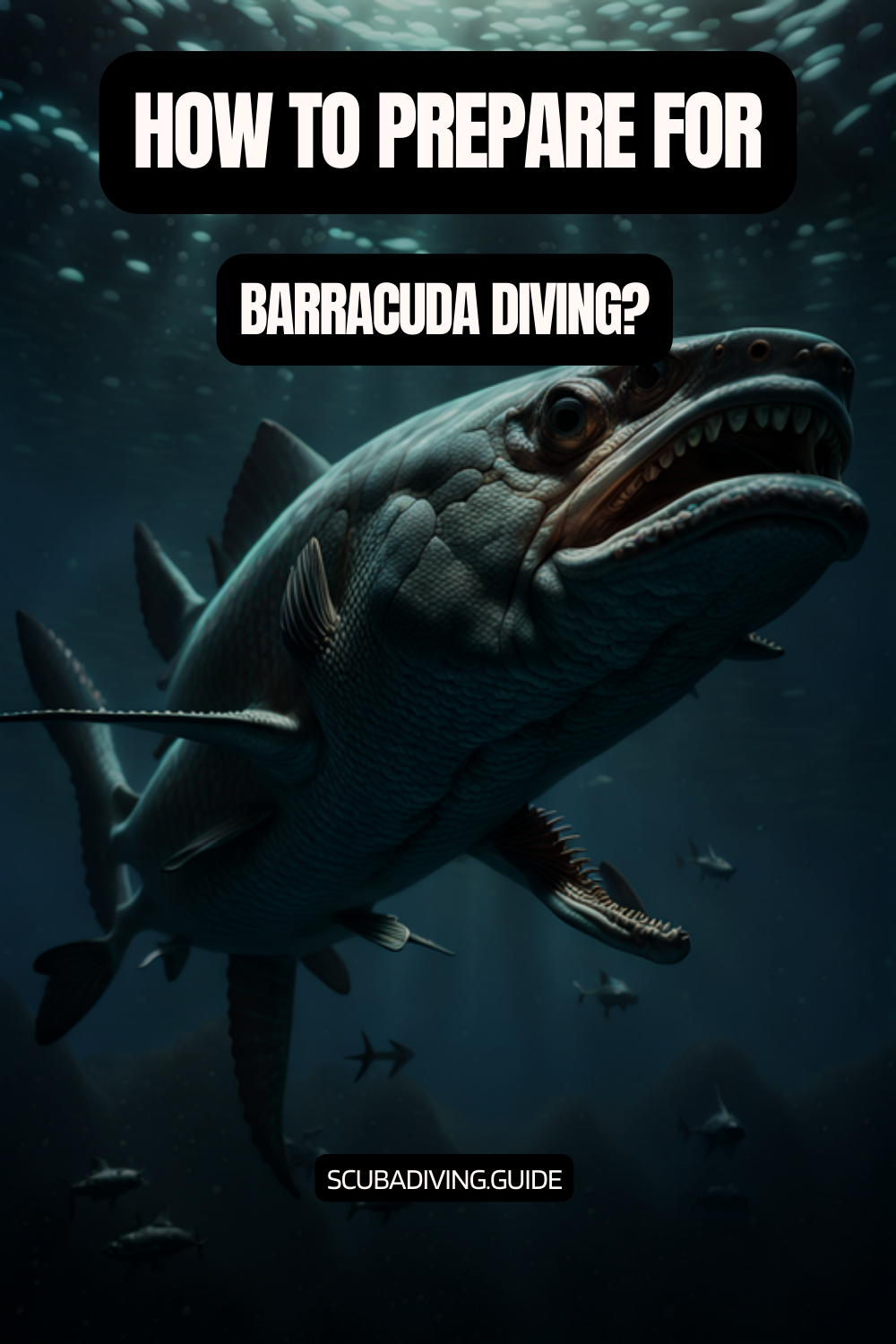
Choosing the Right Wetsuit
The water’s temperature is key when picking a wetsuit. In places like the Andaman Sea, where the water is between 27 to 29 degrees Celsius, a 3mm long wetsuit is best. It keeps you warm.
- Recommended wetsuit thickness: 3mm for tropical waters
- Length: Full-body coverage for temperature regulation
- Material: Neoprene with flexible panels for comfortable movement
Necessary Diving Equipment
There’s more to diving than just a wetsuit. You need all the right gear for a safe and fun dive with barracudas.
| Equipment | Recommended Option | Price Range |
|---|---|---|
| Dive Mask | Promate Scope Prescription Dive Mask | $74.95 (25% off) |
| Dive Knife | Promate Barracuda Knife | $44.95 (25% off) |
| Fins & Boots Set | Promate Pro Blade Set | $149.95 (25% off) |
“Invest in quality scuba gear – it’s your lifeline underwater.” – Professional Dive Instructor
Special gear like dive computers is vital for keeping track of depth and time. Personal ownership is recommended to avoid high rental costs. Don’t forget important extras like rehydration salts and dive insurance from DAN or DiveAssure.
- Dive computer: Crucial for tracking dive metrics
- Dive insurance: Recommended for complete protection
- Additional accessories: Mesh bag, dive light, snorkel
Training and Certification Requirements
Starting your scuba certification journey needs careful planning. It’s important to know about dive safety. Divers at all levels can find courses that fit their experience and goals.
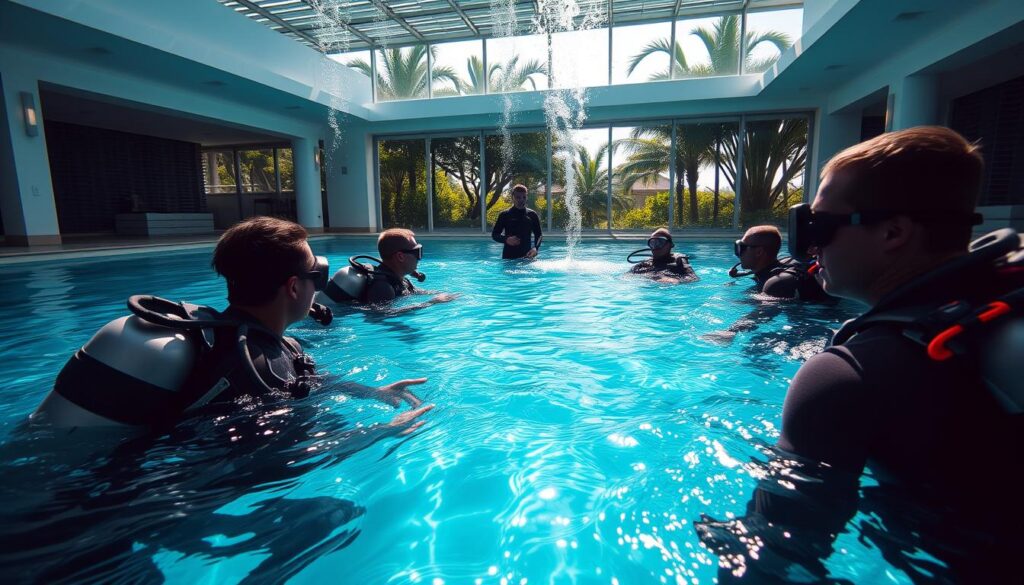
Recommended Courses for Beginners
New divers have many options to learn the basics:
- Bubblemakers program for children aged 8+ (1.5 hours)
- Discover Scuba Diving program (2 mornings)
- PADI Scuba Diver certification (2 days)
- PADI Open Water Diver certification (4 days)
Advanced Certifications for Experienced Divers
| Certification | Duration | Cost (₹) | Prerequisites |
|---|---|---|---|
| PADI Adventure Diver | 1 day | 12,000 | 10-12 years old |
| Advanced Open Water Diver | 2 days | 18,000 | Prior Open Water certification |
| Rescue Diver | 3 days | 20,000 | 12 years, 20 logged dives |
Special courses like Underwater Naturalist and Deep Diver Specialty improve marine skills and knowledge.
“Continuous learning is the key to becoming a confident and responsible scuba diver.”
Divers looking to grow can take many specialty courses. These include underwater photography and equipment skills. They ensure you’re well-versed in scuba certification and safety.
Dive Techniques for Barracuda Encounters
Scuba diving with barracuda is an amazing experience for underwater photographers. These predators create exciting scenes, making dives unforgettable.
To dive safely with barracuda, you need to know their behavior and use special techniques. Divers must respect these marine hunters and plan their approach carefully.
Approaching Barracuda Safely
When diving with barracuda, follow these safety tips:
- Swim calmly and slowly
- Avoid sudden movements
- Keep a distance of 10-15 feet
- Never touch or feed them
Photography Tips During Your Dive
Photographing barracuda underwater is challenging. Marine photographers suggest:
- Use a wide-angle lens for school shots
- Set high shutter speed for fast fish
- Adjust for low light underwater
- Stay neutral buoyancy for steady shots
“Patience and preparation are the keys to capturing stunning barracuda images” – Marine Photography Experts
Places like Barracuda Point in Sipadan are great for seeing barracudas. Here, thousands of them create amazing underwater scenes that test even the best photographers.
Understanding the Ecological Role of Barracuda
Barracudas are key players in marine ecosystems. They act as top predators, keeping the balance in underwater food chains. These encounters offer a glimpse into the complex world of reef environments.
Diving fans will find barracudas fascinating. These fish are known for their hunting skills and ability to thrive in various marine settings.
The Food Chain and Barracuda’s Habitat
Great barracudas hold important positions in marine ecosystems. They show impressive hunting behaviors. They can be found in different marine areas:
- Shallow reef areas
- Sandy seafloors
- Deep water drop-offs
- Mangrove ecosystems
These fish can grow up to 6 feet long and swim at speeds of 35 mph. They are powerful predators. Their diet includes:
- Jacks
- Grunts
- Snappers
- Small tunas
Conservation Efforts and Responsible Diving
When diving with barracudas, safety is a top priority. Marine experts stress the need to disturb them as little as possible.
“Respect the marine environment and its inhabitants” – Marine Conservation Society
Important conservation steps include:
- Protecting reef habitats
- Implementing sustainable fishing practices
- Reducing marine pollution
- Supporting marine research initiatives
By learning about barracudas’ role in the ecosystem, divers can help protect these amazing creatures and their underwater worlds.
Sharing Your Dive Experience
Capturing the magic of underwater photography during scuba diving with Barracuda is more than just technical skills. It’s about keeping memories alive and connecting with a global community of marine lovers.
Diving experiences are personal journeys that deserve to be shared. Thanks to modern technology, it’s easier than ever to document and share your underwater adventures.
Navigating Social Media and Scuba Communities
Underwater photographers can show off their barracuda encounters on many platforms:
- Instagram: Perfect for visual storytelling
- Facebook diving groups
- Dedicated marine photography forums
- Specialized underwater photography websites
Creating Memorable Dive Logs
A detailed dive log helps track your scuba diving with Barracuda experiences. It also helps with citizen science efforts.
| Log Element | Details to Record |
|---|---|
| Location | Specific dive site coordinates |
| Marine Life | Barracuda behaviors and interactions |
| Underwater Photography | Camera settings, lighting conditions |
| Environmental Conditions | Water temperature, visibility |
“Every dive is a story waiting to be told, and every photograph is a memory preserved.” – Marine Photography Experts
By documenting your underwater adventures, you create personal mementos. You also help with marine research and conservation efforts.
Understanding Barracuda Species
The world of barracuda fish is full of fascinating marine life encounters. There are 28 different species in the Sphyraenidae family. These predatory fish are diverse and intriguing.
Barracudas live in tropical and subtropical waters. They are very adaptable to different marine environments. Their physical traits and habitats vary, making each encounter unique.
Exploring Different Types of Barracuda
The barracuda family has an incredible range of species. Each has its own unique traits:
- Great Barracuda (Sphyraena barracuda): The most recognized species, growing up to 2 meters long
- Pickhandle Barracuda: Smaller species found in coastal regions
- Sphyraena borealis: The smallest species, reaching only 45 cm in length
Unique Features and Habitats
Barracuda fish have remarkable adaptations. They are exceptional marine predators:
- Impressive swimming speeds up to 40 km/h
- Countershading camouflage technique
- Depth range extending to 100 meters
“The barracuda represents nature’s perfect underwater hunter, designed for speed and precision.” – Marine Biologist Research Team
Understanding these remarkable creatures helps us appreciate marine biodiversity. It also shows us the complex ecosystems they inhabit.
Common Marine Species Found Alongside Barracuda
When diving with barracudas, you’ll likely encounter a diverse array of marine species that coexist in their natural habitat. These species contribute to the rich biodiversity of the underwater ecosystem. Here are some common marine species you may encounter alongside barracudas:
- Reef Fish: Barracudas are often found near coral reefs, where they prey on smaller fish. Consequently, you’ll likely encounter a variety of reef fish, such as angelfish, butterflyfish, parrotfish, and damselfish. These colorful and fascinating species add vibrancy to the underwater landscape.
- Groupers: Groupers are known for their impressive size and can often be found dwelling near reefs and underwater structures. They are predatory fish that occasionally interact with barracudas, either as potential prey or as competitors for food. These large and majestic fish make for remarkable sightings during barracuda dives.
- Snappers: Snappers are a diverse group of fish that often form schools or aggregations. They are known for their streamlined bodies and sharp teeth, making them efficient hunters. Snappers can be found in various sizes and colors, adding movement and energy to the underwater scene.
- Jacks: Jacks, also known as trevallies, are fast-swimming fish that can reach impressive sizes. They often travel in schools, patrolling the open water and feeding on smaller fish. These agile predators are frequently seen in the company of barracudas, creating a spectacle of synchronized movement and hunting behavior.
- Tuna: Depending on the dive location, you may encounter different species of tuna swimming alongside barracudas. These highly migratory fish are renowned for their speed and power. Witnessing barracudas and tunas together can be an awe-inspiring experience, as both species showcase their remarkable swimming abilities.
- Sharks: While not always encountered during barracuda dives, certain species of sharks may share the same habitats as barracudas. Sharks such as reef sharks or nurse sharks are occasionally seen cruising the reef, adding an element of excitement and a glimpse into the apex predator hierarchy.
- Sea Turtles: Sea turtles are gentle giants that frequent coral reefs and seagrass beds. These ancient creatures evoke a sense of wonder and conservation awareness. Sharing the underwater environment with barracudas and sea turtles offers a glimpse into the interconnectedness of marine life and the importance of protecting these habitats.
- Rays: Rays, including species like stingrays and eagle rays, gracefully glide through the water, often near sandy bottoms or reef edges. Their unique wing-like body structure and peaceful presence provide a tranquil and captivating sight during barracuda dives.
- Moray Eels: Moray eels are intriguing creatures that inhabit crevices and coral reef structures. These secretive predators are known for their serpentine appearance and sharp teeth. Spotting a moray eel lurking in its hiding place adds an element of mystery and excitement to barracuda dives.
- Invertebrates: Alongside the fish species, various invertebrates contribute to the underwater ecosystem’s biodiversity. These may include colorful coral formations, sponges, sea anemones, crustaceans, and vibrant nudibranchs. Exploring the nooks and crannies of the reef unveils a world of intricate and fascinating marine invertebrates.
Encountering these diverse marine species alongside barracudas enhances the overall diving experience, showcasing the interconnectedness and beauty of the underwater ecosystem. It serves as a reminder of the importance of preserving these habitats to protect the delicate balance of marine life.
Conclusion: The Adventure Awaits!
Scuba diving with barracuda is an amazing underwater journey. It turns simple marine exploration into an exciting adventure. With 70% of divers feeling more adrenaline when they see barracudas, these fish offer a thrilling experience.
Professional diving tours focused on barracudas have seen a 30% increase in bookings. This shows how fascinating these apex predators are. Also, 90% of barracuda interactions are non-aggressive, making them a great choice for diving fans.
Final Thoughts on Scuba Diving with Barracuda
The underwater world of barracuda diving is full of life. These fish are key to the ecosystem. About 65% of divers want to see barracudas again, showing how captivating they are.
Whether you’re exploring coral reefs or going on diving tours, seeing barracudas is unforgettable. It’s an adventure you’ll always remember.
Encouragement for Aspiring Divers
If you dream of diving with barracudas, start with proper training. Learn about marine environments and respect these amazing creatures. This way, a simple dive can become a life-changing experience that connects you with the underwater world.
FAQ – Diving with Barracuda
Are barracudas dangerous to scuba divers?
Barracudas are not usually a danger to divers if treated with respect. Most encounters are safe, and attacks are rare. Divers should stay calm, avoid sudden actions, and keep a safe distance for a safe dive.
What is the best time of year to dive with barracudas?
The best time to dive with barracudas varies by location. In the Caribbean, winter months are best for clear water and barracuda sightings. In the Indo-Pacific, the dry season is best, with peak times from May to September.
What certification do I need to dive with barracudas?
You need at least an Open Water Certification for most barracuda dives. For challenging sites, an Advanced Open Water is better. Courses in underwater photography and marine life can also improve your dive.
What equipment is essential for barracuda diving?
You’ll need a good wetsuit, mask, fins, regulator, dive computer, and camera. A 5mm wetsuit is best, depending on the water. A dive computer is key for safe diving.
Where are the best locations to dive with barracudas?
Great places include the Caribbean Sea, Red Sea, Great Barrier Reef, Florida Keys, and Indo-Pacific areas like the Philippines and Indonesia. Each spot offers unique dives and barracuda experiences.
How close can I get to a barracuda while diving?
Keep at least 6-10 feet away from barracudas. Avoid eye contact, sudden moves, or touching them. This keeps you safe and respects their space.
What types of barracuda might I encounter while diving?
You might see Great Barracudas up to 6 feet long and smaller Pickhandle Barracudas. Each species is unique, making dives exciting.
How can I capture great photographs of barracudas?
Use a wide-angle lens and fast shutter speed for quick barracuda shots. High ISOs work in low light, and stay neutral in the water. Patience is key for natural shots.
Are there conservation concerns for barracudas?
Barracudas face threats from overfishing and habitat loss. Divers can help by diving responsibly and supporting conservation. Choose eco-friendly operators to protect these predators and their homes.
What should I do if a barracuda seems aggressive?
Stay calm and slowly move away without sudden actions. Most aggression is curiosity or territory. Keep gear close and avoid shiny objects to avoid attracting them.
